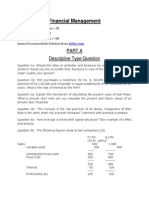Project Appraisal: Specific Instructions
Project Appraisal: Specific Instructions
Uploaded by
अंजनी श्रीवास्तवCopyright:
Available Formats
Project Appraisal: Specific Instructions
Project Appraisal: Specific Instructions
Uploaded by
अंजनी श्रीवास्तवOriginal Title
Copyright
Available Formats
Share this document
Did you find this document useful?
Is this content inappropriate?
Copyright:
Available Formats
Project Appraisal: Specific Instructions
Project Appraisal: Specific Instructions
Uploaded by
अंजनी श्रीवास्तवCopyright:
Available Formats
Code: 561A
Subject:
Project Appraisal
Specific Instructions:
There are four Questions in this assignment. The student should answer all the four questions. Marks allotted 100. Each Question carries equal marks (25 marks) unless specified explicitly.
General Instructions:
The Student should submit this assignment in the handwritten form (not in the typed format) The Student should submit this assignment within the time specified by the exam dept The student should only use the Rule sheet papers for answering the questions.
The student should attach this assignment paper with the answered papers. Failure to comply with the above four instructions would lead to rejection of assignment
Question No 1:
Lucky Computer Stores is making a business plan for the next five years. Sales growth over the past 2 years has been good. Sales would grow substantially if a major electronics firm is established in the vicinity as proposed by an investor. Lucky Computers see 3 options:(i) to enlarge the current store. (ii) to relocate it at a new site and (iii) to simply wait and do nothing. The decision to expand or move would take little time and therefore, the stores would not lose revenue. If nothing were done in the first year and strong growth occurred, then the decision to expand would be reconsidered. Waiting longer than one year would allow competition to move in, making expansion no longer feasible.
The assumptions and conditions are: Strong growth, emanating from the new electronics firm has a probability of 55%. Strong growth with new site would give annual returns of Rs. 1,95,000 p.a. Weak growth with site would mean annual returns of Rs. 1,15,000 p.a. Strong growth with expansion would yield annual returns of Rs. 1,90,000 p.a. Weak growth with expansion would mean annual returns of Rs. 1,00,000 p.a. There would be returns of Rs. 1, 70,000 p.a. at the existing store with no changes in case of strong growth and returns of Rs. 1, 05,000 if growth is weak. Expansion at current site would cost Rs. 87,000. A shift to the new site would cost Rs. 2, 10,000. In case of strong growth, if existing site is enlarged during the 2nd Year, the cost would still be Rs. 87,000. Which option should Lucky Computer Store take, if operating costs for all options are equal?
Question No2
a) Explain Venture Capital Funding of Projects b) What are the major causes for delays and cost overrun in completion of projects? c) What is 'pay back period'? Under what situations investment decisions are mainly guided by pay-back period method? d) What are the main differences between PERT & CPM? a) Brown Field Project
Question No 3
a) S Limited has Rs. 10, 00,000 allocated for capital budgeting purposes. The following proposals and associated Profitability Index have been determined.
Project 1 2 3 4 5 6
Amount (Rs.) 300,000 150,000 350,000 450,000 200,000 400,000
Profitability Index 1.22 0.95 1.20 1.18 1.20 1.05
Which of the above investment should be undertaken?
( Assume that the Projects are indivisible and there is no alternative use of the money allotted for capital budgeting ).
b) How gestation period of an on-going project affects Project financing decisions? c) An Investor wants to invest in a profitable project considering the opportunities available and business environment. As a Financial Advisor , suggest some sources for Project identification d) What is Feasibility Study? e) What are the main objectives of pre-feasibility Study?
Question No 4
a) A company is considering two mutually exclusive projects X and Y. Project X costs Rs. 30,000 and Project Y Rs. 36,000. You are given below the net present probability Project X NPV Estimate (Rs.) 3,000 6,000 12,000 15,000 Profitability 0.1 0.4 0.4 0.1 Project Y NPV Estimate (Rs.) 3,000 6,000 12,000 15,000 Profitability 0.2 0.3 0.3 0.2
1) Compute the expected net present value of projects X and Y 2) Compute the risk attached to each project, i.e. Standard deviation of each probability distributions 3) Which project do you consider more risky and why? 4) Compute the probability index of each project. b) Commercial aspects of the Project to be considered by the institutions: Explain
You might also like
- PM Assignment 2Document4 pagesPM Assignment 2Juan Quiroz67% (3)
- BSBMGT803 QuestionsDocument4 pagesBSBMGT803 QuestionsMuhammad Mubeen0% (2)
- Growth Equity Case Study SlidesDocument13 pagesGrowth Equity Case Study SlidesShrey JainNo ratings yet
- A Dissertation ON: "Strategic Formulation of Distribution Network A Study of Salt-Industry"Document46 pagesA Dissertation ON: "Strategic Formulation of Distribution Network A Study of Salt-Industry"अंजनी श्रीवास्तव100% (2)
- Technical Yield Curve BuildingDocument44 pagesTechnical Yield Curve BuildingsowmikchakravertyNo ratings yet
- Fm202 Tutorial Practice of Past Exam Questions Week12Document3 pagesFm202 Tutorial Practice of Past Exam Questions Week12Grace VersoniNo ratings yet
- Project Appraisal Assignment2Document9 pagesProject Appraisal Assignment2Shashi Bhushan SonbhadraNo ratings yet
- AU FINC 501 MidTerm Exam 2nd Semester2015ss V2Document14 pagesAU FINC 501 MidTerm Exam 2nd Semester2015ss V2Somera Abdul QadirNo ratings yet
- Fm202 Exam Questions 2013Document12 pagesFm202 Exam Questions 2013Grace VersoniNo ratings yet
- Project Appraisal Code568ADocument2 pagesProject Appraisal Code568Amonubaisoya285No ratings yet
- Assignment 1Document11 pagesAssignment 1anon_788536531No ratings yet
- FinancialManagement MB013 QuestionDocument31 pagesFinancialManagement MB013 QuestionAiDLo50% (2)
- Receivables ManagementDocument4 pagesReceivables ManagementVaibhav MoondraNo ratings yet
- Assignment EwcelDocument3 pagesAssignment Ewcelvss.yt15No ratings yet
- Topic 1 - Strategic Thinking Sample Problemsv1Document14 pagesTopic 1 - Strategic Thinking Sample Problemsv1Cleo Coleen FortunadoNo ratings yet
- FM Assignment N0.1Document4 pagesFM Assignment N0.1Hafiz Usman ShariefNo ratings yet
- FINA1310 Assignment 1Document5 pagesFINA1310 Assignment 1timothyNo ratings yet
- Homework 1Document3 pagesHomework 1lizhikunNo ratings yet
- QP March2012 p1Document20 pagesQP March2012 p1Dhanushka Rajapaksha100% (1)
- Group & Individual AssignmentDocument4 pagesGroup & Individual AssignmentKinetibebNo ratings yet
- Imt 07Document4 pagesImt 07Prasanta Kumar NandaNo ratings yet
- School of Business and Law: AssignmentDocument8 pagesSchool of Business and Law: AssignmentMHANo ratings yet
- Mock ExamsDocument30 pagesMock ExamsAuthentic HNo ratings yet
- FINANCIAL ManDocument4 pagesFINANCIAL ManRahul KumarNo ratings yet
- ACC4100-Lesson 3 Self StudyDocument3 pagesACC4100-Lesson 3 Self Studydaljeet singhNo ratings yet
- Business - Analysis Dec-11Document3 pagesBusiness - Analysis Dec-11SHEIKH MOHAMMAD KAUSARUL ALAMNo ratings yet
- Corporate Finance Current Papers of Final Term PDFDocument35 pagesCorporate Finance Current Papers of Final Term PDFZahid UsmanNo ratings yet
- Unit 6 QuizDocument12 pagesUnit 6 QuizMichael JohnsonNo ratings yet
- FINC71-101 Tutorial Solution 08Document7 pagesFINC71-101 Tutorial Solution 08xiaociao199203No ratings yet
- Chapter 02 ProblemsDocument1 pageChapter 02 Problemslovely_mhmdNo ratings yet
- FIN208 Tutorial 4Document3 pagesFIN208 Tutorial 4lkishsNo ratings yet
- CH 08Document12 pagesCH 08AlJabir KpNo ratings yet
- STR 581 Capstone Final Exam All Part 1-2-3Document7 pagesSTR 581 Capstone Final Exam All Part 1-2-3johnNo ratings yet
- Acc 501Document10 pagesAcc 501Devyansh GuptaNo ratings yet
- Sem IV (Internal 2010)Document15 pagesSem IV (Internal 2010)anandpatel2991No ratings yet
- Corporate Finance Practice QuestionDocument5 pagesCorporate Finance Practice QuestionReel LeeNo ratings yet
- Unit 5 - Credit Management - Problem 1Document3 pagesUnit 5 - Credit Management - Problem 1Dennis BijuNo ratings yet
- Peg Sept11 p1Document18 pagesPeg Sept11 p1patriciadouceNo ratings yet
- Questions From Selling To C-SuiteDocument4 pagesQuestions From Selling To C-Suitekennethwcw2515No ratings yet
- Financial Management: F9FM-MT1A-Z08-QDocument7 pagesFinancial Management: F9FM-MT1A-Z08-QErclanNo ratings yet
- ACC 291 Week 5 Practice QuizDocument44 pagesACC 291 Week 5 Practice Quizoi365No ratings yet
- Financial ManagementDocument46 pagesFinancial ManagementChirag VoraNo ratings yet
- Assessment Paper and Instructions To CandidatesDocument3 pagesAssessment Paper and Instructions To CandidatesJohn DoeNo ratings yet
- f5 Examreport s16Document5 pagesf5 Examreport s16ADITHYA KOVILINo ratings yet
- 254 Chapter 10Document23 pages254 Chapter 10Zidan ZaifNo ratings yet
- 5 - HI5002 Finance Tutorial Question Assignment T2 20202 Questions-AG 150920Document6 pages5 - HI5002 Finance Tutorial Question Assignment T2 20202 Questions-AG 150920ahmerNo ratings yet
- Cost PMPDocument36 pagesCost PMPMitsubishi FA Riyadh-Saudi ArabiaNo ratings yet
- N1591 2019-20 - Sample Exam QuestionsDocument11 pagesN1591 2019-20 - Sample Exam QuestionsMandeep SNo ratings yet
- Grile Examen - ForecastingDocument7 pagesGrile Examen - ForecastingViking OmuNo ratings yet
- Homework 1 Directions - ModB2015Document3 pagesHomework 1 Directions - ModB2015obliv110% (1)
- Question PaperDocument7 pagesQuestion Papertriptirajpurohit769No ratings yet
- Project Finance Question PaperDocument3 pagesProject Finance Question PaperBhavna0% (1)
- Accounting CaDocument9 pagesAccounting CatejaswiNo ratings yet
- advanced-financial-management-full-test-1-may-2024-Test-Paper-1708156392Document28 pagesadvanced-financial-management-full-test-1-may-2024-Test-Paper-1708156392divakaranbas01No ratings yet
- Unit III Capital BudgetingDocument37 pagesUnit III Capital Budgetingadarsh sharmaNo ratings yet
- Project Appraisal MBA-IVDocument11 pagesProject Appraisal MBA-IVnareshbansal130No ratings yet
- Assignment 2 SolutionsDocument12 pagesAssignment 2 SolutionsJona ThanNo ratings yet
- Entrepreneurship Essentials - Unit 14 - Week 11Document1 pageEntrepreneurship Essentials - Unit 14 - Week 11SANDEEP JADAUN67% (3)
- 3 - 0607 - Making Capital Investment Decisions. Risk Analysis, Real OptionsDocument3 pages3 - 0607 - Making Capital Investment Decisions. Risk Analysis, Real OptionsPham Ngoc VanNo ratings yet
- ACC501 01 FINAL Fall20082-1Document15 pagesACC501 01 FINAL Fall20082-1Fun NNo ratings yet
- Execution Excellence: Making Strategy Work Using the Balanced ScorecardFrom EverandExecution Excellence: Making Strategy Work Using the Balanced ScorecardRating: 4 out of 5 stars4/5 (1)
- Industrial Megaprojects: Concepts, Strategies, and Practices for SuccessFrom EverandIndustrial Megaprojects: Concepts, Strategies, and Practices for SuccessRating: 3 out of 5 stars3/5 (3)
- Subject: India's Foreign Trade PolicyDocument1 pageSubject: India's Foreign Trade Policyअंजनी श्रीवास्तवNo ratings yet
- Marketing Mix in With Special Reference To Product, Price, Promotion and PlaceDocument73 pagesMarketing Mix in With Special Reference To Product, Price, Promotion and Placeअंजनी श्रीवास्तवNo ratings yet
- Quality Manual - IsO 900Document31 pagesQuality Manual - IsO 900अंजनी श्रीवास्तवNo ratings yet
- Services Marketing, LICDocument107 pagesServices Marketing, LICअंजनी श्रीवास्तवNo ratings yet
- TallyDocument22 pagesTallyअंजनी श्रीवास्तवNo ratings yet
- Financial Derivatives: An International PerspectiveDocument131 pagesFinancial Derivatives: An International Perspectiveअंजनी श्रीवास्तव0% (1)
- Finance Statement Raidco KhaithanDocument44 pagesFinance Statement Raidco Khaithanअंजनी श्रीवास्तवNo ratings yet
- Credit Cardt-Plstic MoneyDocument57 pagesCredit Cardt-Plstic Moneyअंजनी श्रीवास्तवNo ratings yet
- Section Iv Dental Colleges: (Conducted by CBSE, New Delhi)Document66 pagesSection Iv Dental Colleges: (Conducted by CBSE, New Delhi)अंजनी श्रीवास्तवNo ratings yet
- World Wide Web (WWW) : New Mass Medium: Capabilities and Expectations of The WebDocument3 pagesWorld Wide Web (WWW) : New Mass Medium: Capabilities and Expectations of The Webअंजनी श्रीवास्तवNo ratings yet
- The Wto: The Result Is Assurance. Consumers and Producers KnowDocument77 pagesThe Wto: The Result Is Assurance. Consumers and Producers Knowअंजनी श्रीवास्तवNo ratings yet
- WTO1Document38 pagesWTO1अंजनी श्रीवास्तवNo ratings yet
- Year 1991Document7 pagesYear 1991अंजनी श्रीवास्तवNo ratings yet
- The World Trade Organization (WTO) Is The Only International OrganizationDocument17 pagesThe World Trade Organization (WTO) Is The Only International Organizationअंजनी श्रीवास्तवNo ratings yet
- Assignments For All Subjects August 2013Document10 pagesAssignments For All Subjects August 2013अंजनी श्रीवास्तवNo ratings yet
- Non-Governmental Organisations and Child Labour: (Case Studies in Two Cities of Andhra Pradesh)Document13 pagesNon-Governmental Organisations and Child Labour: (Case Studies in Two Cities of Andhra Pradesh)अंजनी श्रीवास्तवNo ratings yet
- Mar ' 13 Mar ' 12 Mar ' 11 Mar ' 10 Mar ' 09Document2 pagesMar ' 13 Mar ' 12 Mar ' 11 Mar ' 10 Mar ' 09अंजनी श्रीवास्तवNo ratings yet
- Assignment Business StatisticsDocument3 pagesAssignment Business Statisticsअंजनी श्रीवास्तवNo ratings yet
- Internet and Its Impact On The SocietyDocument25 pagesInternet and Its Impact On The Societyअंजनी श्रीवास्तवNo ratings yet
- Assignment Business StatisticsDocument3 pagesAssignment Business Statisticsअंजनी श्रीवास्तवNo ratings yet
- Trading DayDocument15 pagesTrading DaydmidNo ratings yet
- Chapter 2: Stock Investments - Investor Accounting and ReportingDocument36 pagesChapter 2: Stock Investments - Investor Accounting and Reportingnikitarani kikiNo ratings yet
- Wasim Ahmad: Educa OnDocument5 pagesWasim Ahmad: Educa OnabigmanNo ratings yet
- WalMart Case ExhibitsDocument12 pagesWalMart Case ExhibitsAshish KumarNo ratings yet
- SIP Mantra - HDFC Flexi Cap Fund (Aprt 2023)Document2 pagesSIP Mantra - HDFC Flexi Cap Fund (Aprt 2023)DeepakNo ratings yet
- Individual Assignment - Financial ManagementDocument2 pagesIndividual Assignment - Financial ManagementrenaldooNo ratings yet
- What Is A Dividend?: Key TakeawaysDocument6 pagesWhat Is A Dividend?: Key TakeawaysShayan ZafarNo ratings yet
- Promotional Material For Study GuideDocument5 pagesPromotional Material For Study GuideStars2323No ratings yet
- Basic Accounting Prequalifying SolManDocument12 pagesBasic Accounting Prequalifying SolManAnj SueloNo ratings yet
- TBChap 010Document19 pagesTBChap 010Tiến Thành TrầnNo ratings yet
- Cash Flow Statement Numericals QDocument3 pagesCash Flow Statement Numericals QDheeraj BholaNo ratings yet
- Currency Trader Magazine 2011-06Document31 pagesCurrency Trader Magazine 2011-06Lascu RomanNo ratings yet
- AccountingDocument21 pagesAccountingRoma Medina ParaginogNo ratings yet
- Basis Technical AnalysisDocument92 pagesBasis Technical Analysisrahulsheth_cal2159No ratings yet
- Accounting Finance For EngineersDocument16 pagesAccounting Finance For EngineersSubashiиy PяabakaяaиNo ratings yet
- Return, Risk, and The Security Market LineDocument45 pagesReturn, Risk, and The Security Market Lineotaku himeNo ratings yet
- General Ledger: March 8 Purchased Furniture in Credit 26,000 MarchDocument7 pagesGeneral Ledger: March 8 Purchased Furniture in Credit 26,000 MarchCarla AlvarezNo ratings yet
- Where Is Value Won or Lost For FPSO Owners and Investors?Document27 pagesWhere Is Value Won or Lost For FPSO Owners and Investors?Dare SmithNo ratings yet
- Currency Derivative1Document47 pagesCurrency Derivative1IubianNo ratings yet
- Lecture Topic 3d - Stock ValuationDocument28 pagesLecture Topic 3d - Stock ValuationNur SyahirahNo ratings yet
- Issue ManagementDocument30 pagesIssue Managementmohanbkp100% (2)
- Activity 1 Introduction To Cost AccountingDocument6 pagesActivity 1 Introduction To Cost AccountingJenny AstroNo ratings yet
- Corporate Finance Interview Questions PDFDocument6 pagesCorporate Finance Interview Questions PDFNidhi SurveNo ratings yet
- Q2 Entrepreneurship - Module 2 - Business ImplementationDocument15 pagesQ2 Entrepreneurship - Module 2 - Business Implementationjhonellagarcia00No ratings yet
- Exane 2Document19 pagesExane 2alan_s1No ratings yet
- FAC1502 - Study Unit 8 - 2023Document27 pagesFAC1502 - Study Unit 8 - 2023tleggat69No ratings yet
- ACCT-UB 3 - Financial Statement Analysis Module 2 HomeworkDocument2 pagesACCT-UB 3 - Financial Statement Analysis Module 2 HomeworkpratheekNo ratings yet
- Intermediate Financial Accounting 1 1657742265Document803 pagesIntermediate Financial Accounting 1 1657742265Ian UyNo ratings yet
- Dokumen - Tips - Kpmgcom C e 206 M 271 KPMGF Main Report Ec Feasibility Study On Capital MaintenanceDocument442 pagesDokumen - Tips - Kpmgcom C e 206 M 271 KPMGF Main Report Ec Feasibility Study On Capital Maintenancehope mfungweNo ratings yet













































































































